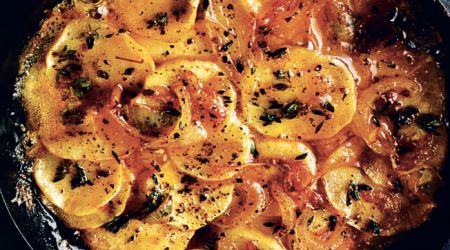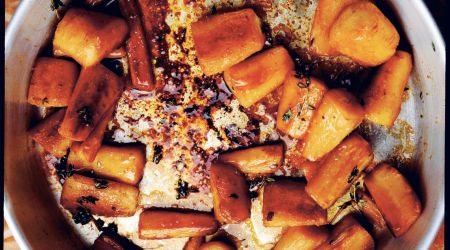Parsnips
Sweet and starchy, these roots are great winter warmers – whether roasted, fried or simmered in steaming soups, says Clarissa Hyman with recipes by Linda Tubby
‘Fine words butter no parsnips’ has to be one of the oddest idioms in the English language. I know it’s meant to express the notion that action counts for more than flattery or promises, but even if you say it in a deep West Country growl, it sounds pretty daft. Especially, perhaps, if you say it in a deep West Country growl.
The phrase’s 17th-century origin is rather tortuous: root vegetables when cooked need butter like pot plants need water – in other words, they need ‘buttering-up’. Ta- dah! The butter bit relates to the image of fine words oiling and smoothing the process of persuasion. But why parsnips? Why not turnips or celeriac?
Perhaps it was because parsnips were once much more common in the British diet than they are today. Or because our ancestors appreciated the value of a crop that dates to Roman times. The cultivated taproot, Pastinaca sativa, developed out of the umbelliferous wild parsnips that grow throughout central and southern Europe. It became one of the main crops grown by Anglo-Saxon farmers after the end of the Roman Empire (although the ancient writers did not distinguish too much between parsnips and carrots).
Parsnips were particularly valued for their sugar content in medieval Europe, where there was a dearth of sweeteners; cane sugar was a rare, imported luxury and honey was expensive. After crushing the parsnip, the liquid was drawn off, boiled and used like honey. Parsnips could also be fermented for wine or beer, or used as a jam and in sweet puddings and tarts.
Before the introduction of potatoes, they were among the main sources of starch in the common diet, included in the cooking pot or roasted in the pan beside the meat. Roasting, in particular, brings out the sugar content so they caramelise beautifully and have an earthy, sweet flavour. In Elizabethan times, buttered parsnips were dusted with ginger for added sweetness while parsnip fritters were sprinkled with sugar.
The 17th-century herbalist John Evelyn also suggested boiling the parsnip and serving it as a winter salad with oil and vinegar. Hannah Glasse, writing in the 1740s, gave a recipe for salt cod with hard- boiled eggs melted in butter and ‘parsnips boiled and beat fine with butter and cream’.
Yet parsnips have never been particularly popular in the rest of Europe. The main use in France is in a pot-au-feu, and in Italy parsnips are fed to pigs reared for San Daniele and Parma ham. The Americans, however, cook it in much the same way as the British: as a rich, sweet, glazed vegetable for Thanksgiving and Christmas.
In the rural English tradition, parsnips were often the main course, baked with a little fat bacon or boiled with pickled pork. Boiled plum puddings were made with a parsnip base and flavoured with spice and honey. It was Jane Grigson who, in more recent times, rediscovered the way spices offset the sweetness of the parsnip, and her seminal recipe included the addition of curry powder at the beginning of cooking. Parsnip croquettes with a dash of cumin and black pepper are also surprisingly good as part of an Indian meal.
Gordon Ramsay adds a magic touch with honey, cinnamon, thyme and star anise seasoning to glazed, golden parsnips and carrots, but coriander, fennel and cardamom also work well. Alternatively, go the creamy route by mashing the parsnips in hot milk with garlic, lemon juice, olive oil and ground almonds.
Parsnips also marry beautifully with seasonal fruit: Richard Corrigan suggests a recipe of roast partridge with pears and parsnips, or you can bake them with orange juice, maple syrup, butter and mustard. Arthur Potts Dawson, on the other hand, explores the pairing of parsnips with eastern flavours in a salad of parsnip, shiitakes, soy and mirin. Parsnips may look slightly like carrots but they are white, taste sweeter and have a more complex, earthy flavour.
Although the roots are not always to everyone’s taste, I have met few people who dislike them roasted or deep-fried, when the flavour intensifies but does not become cloyingly sweet (on the other hand, just about everything tastes better deep-fried). From a nutritional point of view, they are rich in potassium, folic acid and natural fibres, and are also a source of vitamins and mineral salts, just like their orange cousin. They are, however, all too often underrated, seen as dull and difficult by comparison.
Once parsnips have been through a frost, the starch in the roots turns to sugar, so parsnips should always be eaten in midwinter – although some claim that is just an old wives’ tale to stop you eating your winter vegetable store too early. Gardeners can leave them in the ground and dig them when needed, although if left too long, they may grow huge, up to 40cm, and develop a woody core. Good varieties for home-growing include White King, which has a fine flavour, and Tender and True, with its long, tapering roots and sweet flesh. Parsnip seeds, however, are notoriously fickle in germination, which can make it difficult to establish an even crop or uniform root size.
If you don’t dig your own, look out for mud-encrusted roots from your local farm shop – snap them in half to discover how clean, fresh and sweet they smell when freshly dug. Small and medium parsnips are likely to be less fibrous than large ones and need little-to-no peeling, just trimming. Avoid those that are bruised, slimy or flabby, or have brown, rotten patches.
Anyhow, enough of these fine words. I have to go butter my parsnips.

Recipes
Get Premium access to all the latest content online
Subscribe and view full print editions online... Subscribe



